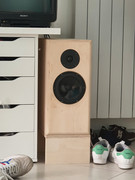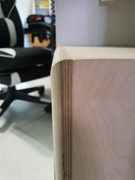Hello everybody. I wanted to know if anyone in his diy project used seas 27tdfc and seas ca18rly (or similar) as speakers. in fact, I wanted to compare on the type of crossover you used. my crossover is composed as follows:
Tweeter: series 4.7ohm-8.2uF. Parallel 0.150mH
Midwoofer: series 2,4mH. Parallel 12uF-1ohm.
thanks to those who want to participate!
Tweeter: series 4.7ohm-8.2uF. Parallel 0.150mH
Midwoofer: series 2,4mH. Parallel 12uF-1ohm.
thanks to those who want to participate!
Last edited:
That setup could work. Did you measure the response and impedance of both units in the enclosure?
Last edited:
I kind of like/hate this tweeter as it brings too much of it's own character and my samples are quite off from each other above 6-7kHz. On top one is 1dB more efficient in the crossover area.
I have generally had a bad time with 6" bass plus 1" tweeter.
Problems:
Bad time alignment.
Poor bass due to undersize box. 18L reflex minimum IMO.
Approximately 5kHz midbass breakup. Mucks up phase for one thing.
Low crossover required.
Worst of all, it sounds tonally unbalanced.
Seems the problem on the tonality is a shout at about 700Hz. Male voices forward, female voices recessed.
Your crossover may fall into the "THE TOO OFTEN SEEN CROSSOVER SCHEMATICS" as Mr. Troels Gravesen says:
SEAS CURV
Since most SEAS drivers are quite similar...
H1217-08 CA18RLY
H1456-08 ER18RNX
H1571-08 U18RNX/P
There may be a one-size-fits-all solution. A midrange presence notch.
You might email Michael Chua for his circuit for the Starling-V (the Final Cut) – AmpsLab
Seas ER18RNX with 27TDFC
Clearly done a lot of work on this one. I suspect it is a complicated circuit. 😀
Problems:
Bad time alignment.
Poor bass due to undersize box. 18L reflex minimum IMO.
Approximately 5kHz midbass breakup. Mucks up phase for one thing.
Low crossover required.
Worst of all, it sounds tonally unbalanced.
Seems the problem on the tonality is a shout at about 700Hz. Male voices forward, female voices recessed.
Your crossover may fall into the "THE TOO OFTEN SEEN CROSSOVER SCHEMATICS" as Mr. Troels Gravesen says:
SEAS CURV
Since most SEAS drivers are quite similar...
H1217-08 CA18RLY
H1456-08 ER18RNX
H1571-08 U18RNX/P
There may be a one-size-fits-all solution. A midrange presence notch.
You might email Michael Chua for his circuit for the Starling-V (the Final Cut) – AmpsLab
Seas ER18RNX with 27TDFC
Clearly done a lot of work on this one. I suspect it is a complicated circuit. 😀
Full polar measurements and simulator like VituixCAD would reveal what the problemo is. It is no problem to make very good crossover for given physical/acoustic design of the speaker with proper measurements and simulator. If the response is not good no matter how crazy crossover network is, the acoustic/physical design of the speaker needs a revisit. Cheerios!🙂
Steve, the CA18RLY is nothing like the ER18RNX, and has a wonderful midrange. It requires a large box (30L or so), but is otherwise well behaved, no notches required. The time alignment/phase stuff can be sorted by going one order higher on the tweeter
Last edited:
Full polar measurements and simulator like VituixCAD would reveal what the problemo is. It is no problem to make very good crossover for given physical/acoustic design of the speaker with proper measurements and simulator. If the response is not good no matter how crazy crossover network is, the acoustic/physical design of the speaker needs a revisit. Cheerios!🙂
With respect to those who wish to reinvent the wheel, I say WHY BOTHER! 😀
SEAS have measured their products far better than you can:
H1217-08 CA18RLY
http://www.seas.no/images/stories/prestige/pdfdatasheet/h1189_27tdfc_datasheet.pdf
I really think this design will work as well as most:
CA18RLY/22TAF-G
Maybe a bit of level adjustment on the different tweeter. How hard is that?
Hi, yeah there is only so much one can do in the crossover since it is only half of the system. Purpose of the crossover is to divide the signal electrically so that the output of several transducers combine back acoustically. Manufacturer measurements are not done in your enclosure but on some test conditions that don't match your box. Since the box and all the drivers on it is quite big part of the acoustic output there is no way you get optimal crossover without measuring the actual complete speaker at hand. When you do, you have true information what the acoustic output is, what the predicted in room response is and there is possibility to get optimal crossover network for optimal sound at listening position. I think it is silly to not use this information unles audio quality is not a goal. There is no magic pill, good performance needs some extra work over slap on design.
Of course there is possibility there is no good electric crossover for given system and the acoustic design needs to be changed. For example baffle diffraction might be the culprit for shoutyness at mids. You could see this and sim what needs to be changed in order to make the system work better. Phase issues, easy to see. In room response, pretty close with early reflections included.
If you are very experienced you might get very good results but a beginner stands no chance for good speaker design without good information. With measurements and VituixCAD any beginner is capable of designing speaker that has no issues. Requires learning the measurement and simulation procedure, and what is good and what is bad but after the learning process there really is no need for second guessing what crossover works or not. Peace 🙂
Of course there is possibility there is no good electric crossover for given system and the acoustic design needs to be changed. For example baffle diffraction might be the culprit for shoutyness at mids. You could see this and sim what needs to be changed in order to make the system work better. Phase issues, easy to see. In room response, pretty close with early reflections included.
If you are very experienced you might get very good results but a beginner stands no chance for good speaker design without good information. With measurements and VituixCAD any beginner is capable of designing speaker that has no issues. Requires learning the measurement and simulation procedure, and what is good and what is bad but after the learning process there really is no need for second guessing what crossover works or not. Peace 🙂
Last edited:
- Home
- Loudspeakers
- Multi-Way
- Seas 27tdfc, seas ca18rly - crossover thread


